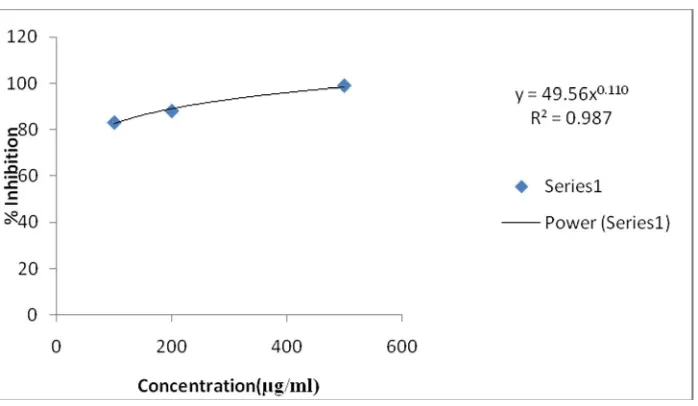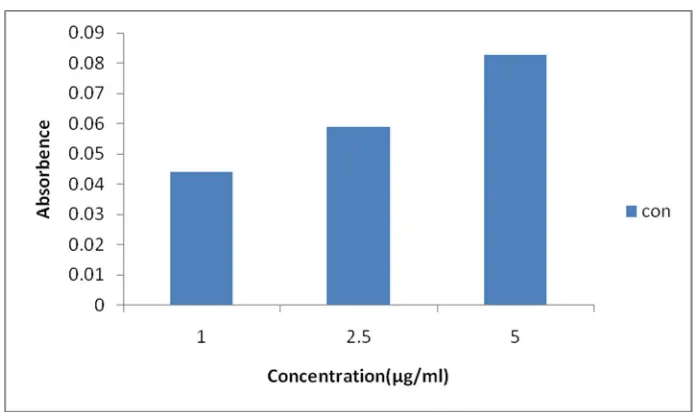INTERNATIONAL JOURNAL OF PHARMACEUTICAL, CHEMICAL AND BIOLOGICAL SCIENCES
Available online atwww.ijpcbs.com
INVITRO EVALUATION OF ANTIOXIDANT ACTIVITY OF ETHANOLIC LEAF
EXTRACT OF IXORA COCCINEA
V. Ravi Kumar, K. Ravi Shankar* and P. Priyabhandhavi
Sri SaiAditya Institute of Pharmaceutical Sciences and Research, ADB road,Surampalem, East Godavari(Dt.), Andhra Pradesh, India.
INTRODUCTION
Free radicals and active oxygen species plays an important role in initiation andevaluation of numerous diseases2. Antioxidants are the first line of defense against free radical damage and are critical for maintaining optimum health. Antioxidants are emerging as prophylactic and therapeutic agents for various diseases like cancer [2, 3], diabetes, cardiovasculardisorders, braindysfunction,
inflammation and other degenerative
diseases2.antioxidants delays the ageing and formation of white hairs in early age.
Ixoracoccinea is the evergreen perennial
shrub through south East Asia belonging to family Rubiaceae. The genus ixoracontains more than 400 species. Ixoracoccinea is commonly known as jungle of geranium and
flame of the woods or vetchi in
ayurveda4.Ixora coccinea have different colours of flowers like red, white, yellow, orange,and pink1. Leaves contain the chemical constituents [5, 6] like A-type
trimericproanthocyanidin, epicatechin,
procyanidineA2,
cinnamatanninB-1,flavonols,kaemferol,quercetin,phenolic acids,ferulicacids, mixtureof hydrocarbons, sesquiterpens, steroids and alcohols, mixture
of lupeol. Leaves have
showantimicrobial7,antinociceptive8,antiinfla
mmatory9, hypolipidaemic and
hypoglycaemic6, antimicrobial10, anti-ulcer5, chemoprotective activities4. Flowers contain quercetin, cyanidin, flavonoids,ash 6.4%, tannins, lupeol, fatty-acids, beta-sitosterols,
cycloartenol-esters, triterpenes,
monoterpenes, sesquiterpenes11. Flowers used as hepatoprotective, antidiarrheal, cytotoxic, antimicrobial, wound healing12and anti-inflammatory effect. Roots are having aromatic acria oil, tannins, and fatty acids. Roots having anthelmintic13 and antibacterial activities. The present investigation was carried out to evaluate the antioxidant
property of ethanol leaf extract
ofIxoracoccinea.
Research Article
ABSTRACT
The present study deals with the antioxidant potential of Ixoracoccinea leaves collected from Ibrahimpatnam of Krishna dist belonging to the family Rubiacea. In this study we tried to explore the antioxidant activity by using DPPH, reducing power, and nitric oxide assay methods. The results are compared with standard Gallic acid. The results showed the appreciable and concentration dependent antioxidant activity.
MATERIALS AND METHODS Plant material
The leaves ofIxoracoccinea were collected from the surrounding areas of Vijayawada thermal power station [V.T.P.S] located at ibrahimpatnam of Krishna district. The leaves were collected and shade dried and then powered to get a coarse powder.
Preparation of extract
The dried powder materials was macerated by using 90% ethanol for five days and percolated for 500c. The percolated mixture was filtered and filtrate was collected and solvent was evaporated. The residue was kept indescicator.
Chemicals and equipment
Gallic acid [gifted sample],Dpph [purchased
from research lab fine chemical
industries,Mumbai],phosphate buffer [0.2M,
PH 6.6],potassium ferricyanide,
trichloroaceticacid,ferricchloride,methanol,so diumnitroprusside,sulphanilamide,H3PO4,
naphthyl ethylene
diaminedihydrochloride,distilled water. UV-Visible double beam spectrophotometer
[elicosl 210],centrifuge machine,PH
meter,shimadzu electronic balance.
Antioxidant assays
The following assays were performed for evaluation of antioxidant efficacy of the ethanolic leaf extract.
DPPH radical scavenging assay2,3
DPPH [2, 2-diphenyl picrylhydrazyl] is commercially available commonly used stable free radical,which is purple in colour. Antioxidant molecules when incubated, reacts with dpph and converts in to di-phenyl hydrazine which is yellow in colour. The degree of discoloration of purple to yellow was the measure ofscavenging potential of plant extract which was measured at 520nm. Different concentrations of ethanolic leaf
methanol was prepared. 1ml of 0.1 mMdpph solution is mixed with 1ml of all concentrations of both plant extract and standard separately. These 0.1mM dpph solution and gallic acid in methanol mixture is taken as control [blank]. These mixtures are kept in dark for about 30minutes and optical density was measured at 520nm. The dpph radical scavenging activity of ethanolic leaf extract was calculated as the percentage inhibition.
% inhibition of Dpph radical = [AO – At] ×100
Where AO is absorbance of blank,At is absorbance of test. Lower absorbance of the reaction mixture indicate higher free radical scavenging activity. The IC50 and compared with standard. The IC50 value was defined as concentration [1g/ml] of plant extract that scavenges the dpph radicals by 50%.
Reducing power2,3,15
1 ml of various concentrations of ethanolic leaf extract solution was mixed with phosphate buffer [2.5ml, 0.2M, PH6.6] and potassium ferricyanide [2.5ml, 1%]. After the mixture was incubate at 500c for 20 min, trichloro acetic acid [2.5ml, 10%] was added and the mixture was centrifuged at 3000rpm for 10 min. The upper layer of solution [2.5ml] was mixed with distilled water [2.5ml] and ferric chloride [0.5ml,0.1%] and then absorbance was measured at 700nm against a blank. Increased absorbance of
reaction mixture indicated increased
reducing power. Gallic acid was used forcomparison as reference standard. All tests were performed in triplicate and mean values were contexed.
Nitric oxide scavenging assay10,16
nitric oxide which interacts with oxygen to produce nitric ions that can be estimated by using Griess reagent scavengers of nitric oxide compete with oxygen leading to reduce
production of nitric oxide. Sodium
nitroprusside [5mM] in phosphate buffer saline was mixed with 3.0ml of different concentrations of ethanolic leaf extract [100µg/mi, 200µg/ml and500µg/ml] and incubated at 25oc for 180min. the samples
were added to Griess reagent. The
absorbance of chromaphore formed during
the diazotization of nitrite with
sulphanilamide was read at 546nm and referred to absorbance of standard solutions of Gallic acid treated in the same way with Griess reagent as a positive control. The percentage of inhibition was measured similar to that of DPPH assay.
Table 1:DPPH antioxidant assay of Ixoracoccineaethanolic leaf extract
Tested material Concentration
(µg/ml)
% inhibition IC50 value
(µg/ml)
Ethanolic leaf extract of ixoracoccinea
100 200 500
68 ± 0.005 76 ± 0.017 96 ± 0.0173
25.73
Gallic acid 1
2.5 5.0
59.8 ± 0.05 68.16 ± 0.008 80.03 ± 0.024
0.391
Values are the mean ± SEM; n=3
Table2: Nitric oxide assay of Ixoracoccineaethanolic leaf extract
Tested material Concentration
(µg/ml)
% inhibition IC50 value
(µg/ml)
Ethanolic leaf extract of ixoracoccinea
100 200 500
83 ± 0.02 88 ± 0.01 99 ± 0.005
2.07
Gallic acid 1
2.5 5.0
50.53 ± 0.02 69.84 ± 0.028 76.76 ± 0.0057
0.876
Values are the mean ± SEM; n=3
Table 3: Reducing power assay of Ixoracoccineaethanolic leaf extract
Tested material Concentration
(µg/ml)
Absorption ± SEM
Ethanolic leaf extract of ixoracoccinea
100 200 500
0.1103 ± 0.001 0.1741 ± 0.025 0.3808 ± 0.0038
Gallic acid 1
2.5 5.0
Fig. 3: Nitric oxide antioxidant activity ofIxoracoccineaethanolic leaf extract
Fig. 5: Reducing power assay of Ixoracoccineaethanolic leaf extract
Fig. 6: Reducing power assay of Gallic acid (standard)
RESULTS AND DISCUSSION DPPH radical scavenging assay
extract of Ixoracoccinea and Gallic acid respectively.
Nitric oxide scavenging activity
Ethanolic leaf extract exhibited potential inhibiting activity against nitric oxide generation Table-2 nitric oxide is a potent pleiotropic mediator of physiological process. The antioxidant activity of ethanolic leaf extract of ixoracoccinea showed 99% inhibition of nitric oxide generation at 500µg/ml which is compared with standard Gallic acid 5µg/ml concentration shown in fig 3 and 4. The IC50 values were found to be 2.07µg/ml
and 0.876µg/ml for the ethanolic leaf extraction of Ixoracoccinea and Gallic acid. The antioxidant activity increases with the increase in the concentration of extract.
Reducing power
Reducing power assay is used for the measurement of antioxidant activity in the extract. The reducing agents in the extract reacts with the potassium ferricyanide [fe+3] to form potassium
ferrocyanide [fe+2], which then reacts with ferric
chloride to form ferrous complex that has an absorption maximum at 700nm. The reducing capacity of a compound may serve as a significant indicator of its potential antioxidant activity2.
Table-3 shows the reducing power of ethanolic leaf extract of ixoracoccinea from figure 5 and 6 it was found that the absorbance of the extract and Gallic acid increases with increase in concentrations. Reducing power capabilities of extract was found to be closer to Gallic acid.
CONCLUSION
The detected extensive antioxidant study on ixoracoccinealeaf extract reveled that it processes significant antioxidant activity. The presence of several phytoconstituents may be responsible for this activity. So these leaves of ixoracoccinea may be used as rational medicine and further studies can be carried out to explore the chemical constituents responsible for pharmacological studies.
ACKNOWLEDGEMENT
The authors are thank full to the management of srisaiaditya college of pharmaceutical sciences and technology for providing necessary facilities and constant encouragement throughout the research work carried in the institution and also thank full to the staff for their kind cooperation and encouragement during the work
REFERENCES
1. A comparative antibacterial study of Ixoracoccinea plants with red, orange, pink and white flowers; sowjanya. Pulipati,sushma.p,v.jhansilakshmi,p.sriniv asababu; AJPRHC; vol:4; issue-1; 7-10 2. Phytochemical screening and evaluation
of invitroantioxidant activity of mimosa catechu bark; k. Ravi Shankar and ch.sandhya; Biosciences biotechnology research Asia; vol:9; no;1; june-1012 3. Antioxidant activity of ethanolic extract of
ricinuscommunisleaf;k.ravishankar and n.indira; biomedical and pharmacology journal;vol:5[1],2010
4. Pharmacognostical standardization of leaves of Ixoracoccinea, Linn; vadivu. R; read periodical articles, march-1,2010
5. Phytochemical and anti-ulcer
investigation of leaf extract of Ixoracoccinea; vetriselvan.s; euginefelix.
A, magendran. R, ponnayakannan.
S,prabakaran;jothi,Shankar;divan,revathy ; jpr; 2012; vol:5;issue 6
6. Evaluation of hypoglycemic and
hypolipidamic activities of
aqueousextract of leaves of Ixoracoccinea
in diabetic rats;
yasmeenmaniyar,prabhubhixavathimath; jcdr;2011; November; vol-5; issue-7 7. Antimicrobial activity of Ixoracoccinea
leaves; Annapurna. J; amaranth p.v.s; fitoterapia; vol:74,issue-3 April; 2003 8. Antinociceptive action of aqueous extract
of leaves of Ixoracoccinea;
W.D.Ratnasooriya,S.A.Deraniyagala.S.D.N.
K,Bathige.C.L and
goonasekara.j.R.A.C.JAYAKODY; Acta Biol. Hung ;56; 2005
9. Anti-inflammatory activity of
Ixoracoccineamethanolic leaf extract; Handunnetti.S.M,Kumara.R.R,Deraniyagal a.S.A, Ratnasooriya.W.D; Phcog Res; 2009;1
10. Preliminary phytochemical and
antimicrobial investigations of the aqueous extract of Ixoracoccinea and commelinabenghalensis on gram-positive
and gram-negative
microorganisms;mukesh Chandra Sharma and smitaSharma;Middle-Easr journal of scientific research 6[5]; 2010
11. Chemical composition of essential oil of
harcourt,Nigeriaobuzor,Gloriaukalina, nwakanmw,Gibsonuchenna; IJAR march 2011;vol:3, issue-2
12. Effect of Ixoracoccinea flowers on dead
space wound healing in rats;
Nayak.B.S,Udupa.A.L,Udupa.S.L; Filoterapia; june-1; issue-3; 1999
13. Evaluation of anthelmenintic activity of Ixoracoccinea;A.R.Surana,A.N.Aher,S.C.Pal and U.V.Deore;International Journal of Pharmacy and Life Sciences;vol-2,issue-6;june:2011
14. Antioxidant potential of pepper[piper nigrum] leaves and its antimicrobial potential against some pathogenic
microbes;k-Shemmugapriya,PS.Saravana,Harshapayal
,peermohammed and Binnie Williams; Indian journal of Natural Products and Resources;Dec-2012,vol-3,no-4
15. Application of natural products in cosmetic:A Study of Ixoracoccinea extracts for their Antityrosinase and Antioxidant
activities;S.Rohini,M.Shalini,NithyaNaraya
naswamy and
K.P.Balakrishnan;International Journal of Research in cosmetic Science;2012;2[1] 16. Nitric oxide scavenging activity study of
ethanolic extracts of Ixoracoccinea from
two different areas of
kokata;Banerjees,chanda.A,Debanath.S,Ch
akraborty,Saha.R and


